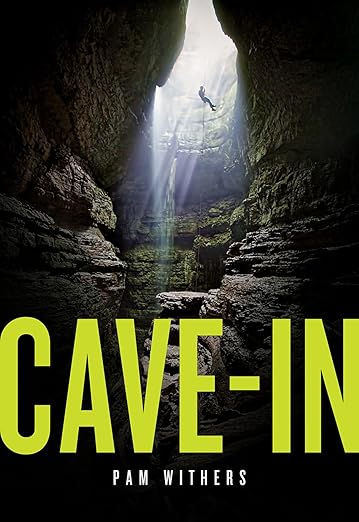Cave-In

Cave-In
Shocked, I grab one of the falling rocks—only to realize it’s not a rock but…a bone. Visibility isn’t great underwater, but when I bring it close to my face it looks like a human bone. An arm bone or something. I wave it through the water like a madman until I manage to unclench my hand and drop it. It sinks slowly to the bottom of the sump, disappearing into the muck I’ve raised with my flailing feet.
Sunken church. Drowned congregation. Haunted churchyard. Oh my God, I’ve dropped the bell clapper on the sideways-lodged bell. The bell of the original church tower. The bell that sank along with my grandfather and the rest of the congregation, too far for anyone to ever find.
Body tremors overtake me. I begin to claw at my own cheeks. For the second time in as many minutes, I have to stop myself from screaming, given that I could drown by taking in water.
Teenager Hudson Greer, an avid and experienced caver in his small Vancouver Island community, while working to find a long-sought connection between two large local cave systems, discovers that logging activity is disrupting the stability of the caves, threatening a sinkhole greater than the one that caused a packed church to sink a generation ago. With few allies—his caving partner Jett, his science teacher, and a logging executive’s daughter—Hudson learns that the connection moves through the church sinkhole site. After his father is seriously injured in a collapse at the logging company’s headquarters, Hudson and his friends determine to expose their shoddy safety practices. A complex scheme to expose the company at a community meeting ends in disaster when the community centre collapses and the cavers and many residents are trapped. Hudson and his friends help free most of the victims, and the logging executive is exposed as having secretly been seeking to mine gold.
Cave-In is a meticulously researched and highly adventurous story, one filled with the wonder and complexity of cave formations and their exploration, all the while exploring the theme of economic development versus environmental stewardship. The character of a small single-resource town is well presented, and the complexity of people finding themselves on both sides of the argument is evident, from Hudson’s parents (both logging employees), to his friend Mica’s father (a former caver, now mayor and logging champion) to Ana, the conflicted daughter of the (later disgraced) logging executive.
On occasion, however, the human complexities seem flat and reduced to caricature, as is the case with Ana’s father, his secretary, and the corrupt safety investigator the company engages. The rivalry between Hudson and his former caving partner Mica is salient but seems exaggerated, as is the decades-long silence of Hudson’s and Mica’s father to keep the secret of the cave connection to themselves lest they defile the memories of their loved ones killed in the tragedy. The flow of the story is engaging but does often lose itself in the complexity of the cave formations and discoveries, and the dialogue tends to be overly verbose, especially for the teenage characters, even for particularly intelligent ones.
The denouement produces similarly mixed results. It is not a pat and happy ending—some four of the 28 people in the community centre collapse die, and Hudson confronts Ana about her deception in their sort-of budding romance. But the comeuppance of Ana’s father, the discovery that the science teacher was trying to save the town’s water because he was planning to start a brewery, and Hudson’s eventual start of a cave tour enterprise (with very quick Parks Canada approval) slightly miss the mark on a satisfying ending to a book meant to appeal to thoughtful young adults.
Todd Kyle is the CEO of the Brampton Library.
